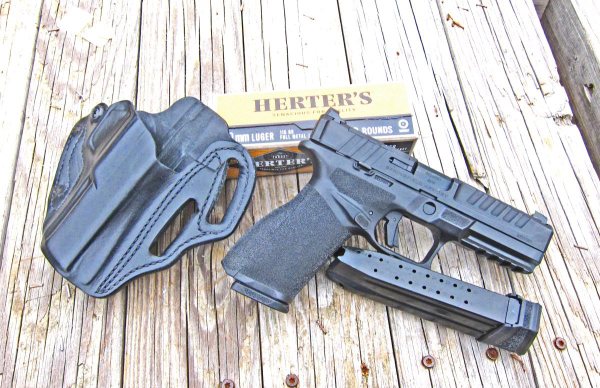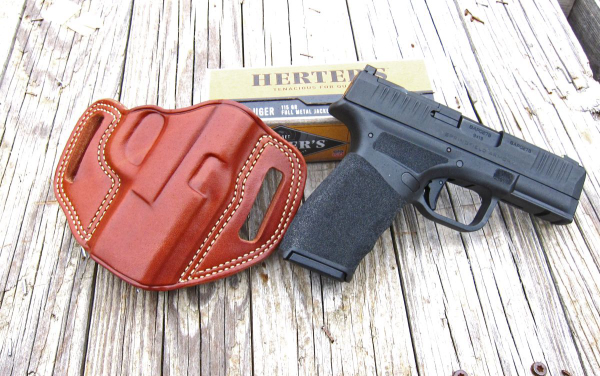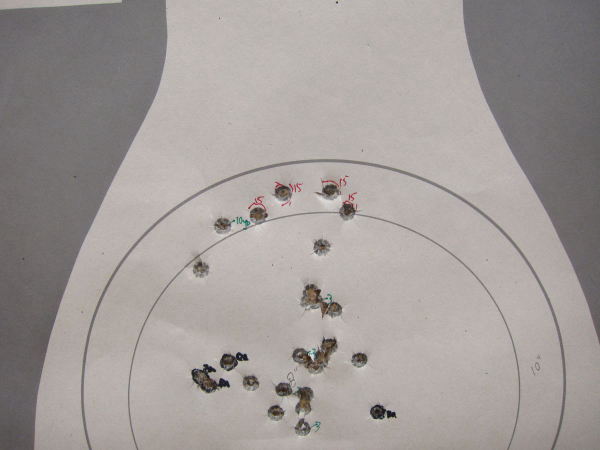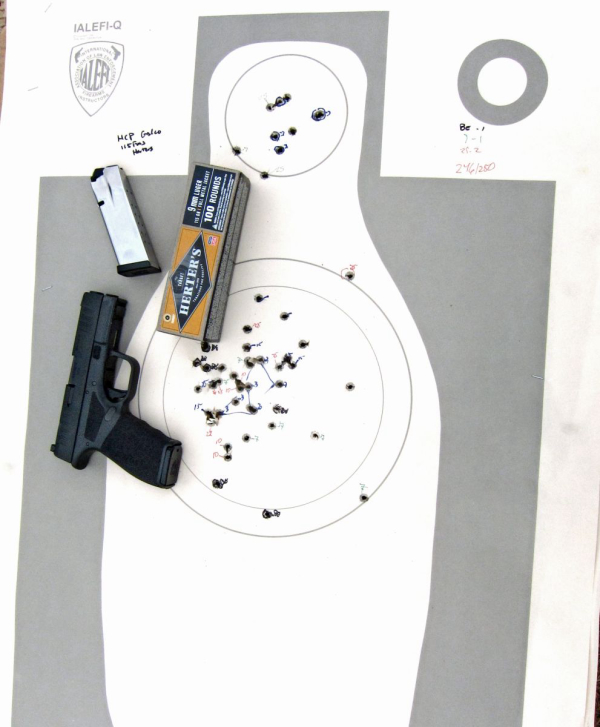Editor’s note: A correction: In last Thursday’s edition, found here, I alluded to “… the news digest of a friend – who would prefer no more subscribers …” That was an error on my part, as he pointed out. The news digest is the Defensive Use of Firearms Digest. To subscribe, follow this link; caveat: “The only issue is that some major corporations - Apple, ATT and Microsoft - block delivery of the Digest to all of their domains, meaning that people using those ISP's need to use webmail addresses such as gmail, yahoo, protonmail, etc.” I apologize for the error.
The current ‘take’ from pros who know is that smaller guns are harder to shoot than larger guns. As usual, when the information comes from someone who has invested considerable time and effort in a field of endeavor, it’s smart to listen. With experience – personal and observing students/new shooters over time, credibility attaches. One such test provided some data here.
I don’t disagree, having run afoul of some small guns I never mastered.
The pros of which I speak aren’t the “short sight radius – bad” crowd, as such. It’s not remarkable that less distance between non-optics “iron sights” can magnify the effect of sighting error particularly at distance or on a small target. Is it enough to be a problem for most shooters?
It’s not the sights, it’s the convulsive clutch of the gun at the instant of ignition – popping the muzzle completely off the target; not just duffers as most of us struggle with this problem over years of experience. Smaller guns sure don’t make that any better.
The question now is if the micro-compact is one of the slightly upsized guns (SIG P365-XMACRO-17 rounds, Springfield Hellcat Pro, etc.) is it significantly more problematic than a service- or service compact pistol to shoot?
Let’s find out.
As I had an example of a new service pistol, the Springfield Armory Echelon, and the smaller gun, the Hellcat Pro (with 15-round mags), I elected to use those.
Aside from the test linked above, you can read previous coverage of the guns at the links below.
Echelon
Springfield Armory Echelon – New Service Pistol
Springfield Armory Echelon Range Work
Editor’s Notebook: Echelon Qual-Style
Hellcat Pro
Springfield Armory’s New Hellcat Pro- Goldilocks and Guns
Shooting the Hellcat Pro
Qualifying with a “Service Micro Compact?”
Editor’s Notebook: Hellcat Pro Under Glass
If I had a SIG P320 and P365XL/XMACRO, that would be a good comparison.
For ammo, I used “available” promotional ball, this being Herter’s-marked 115 grain FMJ from Cabela’s.


To keep the holsters close, I used leather outside-the-waist rigs. The Echelon was holstered in the DeSantis Speed Scabbard. The Hellcat Pro used the Galco Combat Master.
I made a qual-inspired course of standards with each string to be scored individually. They’d have been timed too but the course was shot in inclement weather and there were electronics that were left inside. The target was the IALEFI-Q target.
I. 5 feet, “Bent Elbow,” 2 seconds for each of three strings, Single – Pair – three hits.
II. 10 feet, CQC “head” singles x 5, hand on holstered gun
1 sec. per hit
FL DLE Stage 2, pairs from guard in 1 sec. x 3
III. 20 feet, failure drill from holster – 3 seconds;
Failure drill from guard, WHO – 3 seconds
Draw – 2 SH, 2 WH supported – 4 seconds.
IV. 30 feet, “Wizard,” a pair center in 2.5 sec.
Single from guard x 2, 1 sec.
V. 45 feet, (a) Draw to 3 hits
(b) Pair, guard
(c), (d) Single guard, (2 reps)
VI. 75 feet, single head x 2 reps
Draw to five x 2 reps
That’s 50 rounds total, scored 5 in 8” circle, 4 in 10” circle, 5 in head circle when called for, anything else on the bottle is 3 points. 250 possible.
It was rainy, cool that morning. I started with the service pistol.
Everything was inside back to ten yards, when one leaked out into the 10” ring, high left.
At 15 yards, three wandered high into the -1 zone. On the pair of 25-yard-high percentage attempts, I lost 7 points, one outside the ring on silhouette, one just off into the gray squared-off silhouette. On the pair of five-shot strings, three wandered high out of the rings, losing 6 more points.

I was wearing the SSP Eyewear top focal glasses and used the top section to see the front sight. Apparently, my placement on target was confounded by an inability to put the front sight on a clearly focused point.
Something about the Echelon: I’d checked the optics cover plate screws before shooting; after losing one and getting a replacement from Springfield Armory, I put a paint mark on each screw so I could determine if they worked loose. After the fifteen-yard event – with 38 rounds downrange – the starboard optics cover plate screw had turned. I took that discovery to get the #10 TORX driver (from Lyman) and tighten the screw. I finished the course – all twelve rounds – without further issues.
The final score was 232/250, nothing about which to write home. (93%)
The Echelon has churned through all the tests with no malfunctions.
With the smaller Hellcat Pro, I was surprised that I cleaned the head-shots – not the close ones, but back at 25 yards. It seemed I could get a finer sight picture with the HCP than the Echelon – though it could have been the glasses … I was using the unmagnified lower part of the lens to shoot the smaller gun.

At 25 yards, one of the center hits was just outside of the rings, dropping two points. I was also down one on the “bent elbow/ICE” segment, the first round fired went low. The Echelon was much better at the body index stage. At seven yards, I also dropped one point. This left a score of 246/250 – 98%.
As to the gun, the magazines are tougher to load; you don’t get something for nothing. I had the optics cover plate screws paint-marked. They didn’t move throughout the fifty rounds. It was slower going with the Hellcat Pro, noticeably so.
I shot faster with the bigger gun. That likely didn’t help the score. Shooting faster isn’t the goal, it’s shooting better.
Which gun is better? Well, the Hellcat Pro is snappier, as one would expect. I can get too comfortable shooting the Echelon and it shows. Neither gun created any kind of fatigue, both functioned – here and on previous outings -- with no stoppages save empty-magazine lock-back. As that’s “a feature, not a bug,” it’s not counted against either gun.
I often complained that agency qual courses were less about shooting and more about endurance. It’s the first solid hit that matters. The Hellcat Pro was quick to the first hit, but not necessarily to succeeding hits. If you have trouble managing smaller guns – hands are too big, or you can’t manage the stouter recoil spring of the smaller gun, or anything else, feel free to use the bigger gun.
I’d like to carry the Echelon but I just don't seem to be able to shoot it well. The Hellcat Pro is a different story – for me. Your mileage, as they said in the old commercials, may vary.
— Rich Grassi